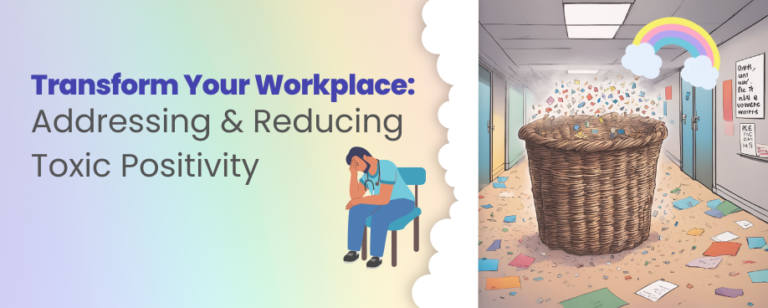It’s Monday morning and you’re in a team meeting. As usual, the room is filled with forced smiles and overly enthusiastic affirmations. “Everything is great!” “We’re all doing amazing!” But your gut tells you otherwise. It doesn’t take long to notice that things aren’t as they seem; beneath the surface, there’s a bubbling undercurrent of stress, frustration, and unresolved issues. The relentless push for positivity has created an environment where genuine emotions are suppressed and real problems are overlooked.
Many workplaces strive to create an upbeat and motivated environment. While the intention is to encourage and uplift teams, this emphasis on relentless positivity can sometimes backfire. Overemphasizing positive thinking can lead to neglecting the real duty of making the workplace a truly safe, productive, and enjoyable space. When the focus is solely on maintaining a cheerful atmosphere, genuine emotions and critical issues may be overlooked, hindering the overall health and effectiveness of the team.
Everyone desires happiness and success in the workplace. Managers and leaders who care enough to address toxic positivity play a crucial role in creating a supportive, productive, and healthy work environment. Let’s explore how we can transform our workplaces by acknowledging and reducing toxic positivity, fostering an environment where genuine emotions are valued, and constructive conversations can flourish.
Understanding Toxic Positivity
What is Toxic Positivity?
Picture it as a thick layer of frosting on a burnt cake. It may look appealing on the outside, but beneath it are real issues that need addressing. Toxic positivity is the overemphasis on positive thinking to the point where it dismisses or invalidates genuine emotions and experiences.
In the workplace, toxic positivity often manifests as platitudes like “Just look on the bright side!” or “Everything happens for a reason.” While these statements might be well-intentioned, they can make employees feel unheard and unsupported. It creates an environment where only positive emotions are acceptable, pushing other valid feelings into the shadows.
The Impact on Employees
Consider Marta, a mid-level manager at a tech company. She came to work with me to improve her stress management skills and overcome workplace anxieties. Despite consistently encouraging her team to “stay positive” and “keep smiling,” productivity was dipping, and morale was low. Her team’s underperformance was getting noticed by her bosses, and she worried about being demoted or fired. It wasn’t until she held a candid discussion with her team that she realized the extent of their struggles. They felt pressured to hide their frustrations and concerns, fearing they would be labeled as negative or uncooperative.
Marta had the best intentions for her team, but when employees feel their true emotions are unacknowledged, they feel invalidated and are less likely to speak up, share ideas, or seek help. This can lead to a culture of silence where issues go unaddressed, creativity is stifled, and employee well-being suffers.
Questions to Reflect On
– How often do you encounter dismissive positivity in your workplace?
– How does it affect team morale and productivity?
– Can you recall a situation where positive sentiments felt forced or disingenuous?
The Impact of Toxic Positivity on Workplace Culture
Emotional Resilience: The Hidden Strength
Emotional resilience is like the root system of a garden, providing the strength and stability needed to thrive. In a workplace where genuine emotions are acknowledged and validated, employees develop the resilience to handle stress and setbacks. However, in an environment dominated by toxic positivity, this resilience can wither.
Psychological Safety: A Foundation of Trust
Psychological safety, the belief that one can speak up without fear of retribution, is the foundation upon which a healthy workplace is built. Toxic positivity can undermine this foundation by signaling that only positive feedback is acceptable. This creates an environment where employees feel unsafe sharing their true thoughts and concerns, leading to a culture of silence and superficial harmony.
Toxic Positivity Yields Diminishing Returns
The effects of toxic positivity are often subtle and slow to manifest. Productivity doesn’t drop overnight; it degrades gradually as emotional resilience and psychological safety diminish. This slow erosion can leave leaders puzzled and frustrated, struggling to understand why their efforts to maintain a positive environment are not yielding the desired results.
Recognizing the Signs
It’s essential for leaders to recognize the signs of toxic positivity and its impact on emotional resilience and psychological safety. Some key indicators include:
- Reluctance to share bad news or challenges.
- Declining team morale despite outward expressions of positivity.
- Increased stress and burnout among employees.
- A noticeable drop in creativity and problem-solving abilities.
By being aware of these signs and taking proactive steps to address them, leaders can prevent the slow decline in productivity and create a more resilient, psychologically safe workplace.
Strategies to Address & Reduce Toxic Positivity
Cultivating Authentic Conversations
Creating a workplace where employees feel comfortable expressing their genuine emotions is essential for addressing toxic positivity. Authentic conversations are the cornerstone of such an environment. Encouraging open dialogue helps build trust and allows team members to share their true feelings without fear of judgment.
Imagine a company where the culture is built on open communication. During a team meeting, a senior executive invites her team to share their current challenges and feelings openly. She starts by sharing her own struggles, setting an example and creating a safe space for others to do the same. As team members begin to express their frustrations and concerns, a more profound sense of connection and understanding develops. This openness not only alleviates individual stress but also fosters a supportive team dynamic.
Training for Empathetic Communication
Leaders play a crucial role in setting the tone for workplace culture. Providing training on empathetic communication can equip managers with the skills needed to address toxic positivity effectively. This training focuses on listening actively, validating emotions, and responding with empathy.
Instead of glossing over negative feedback with positive platitudes, acknowledge team members’ feelings and work with them to find solutions. This shift in approach can lead to increased trust and collaboration among employees.
Implementing Policies that Promote Mental Health Awareness
Another critical strategy is to implement policies that promote mental health awareness. These policies can include regular mental health check-ins, access to counseling services, and workshops on stress management and emotional resilience.
For instance, a tech startup introduced monthly mental health check-ins where employees could speak privately with HR about their well-being. They also offered access to professional counseling and held workshops on topics like mindfulness and stress reduction. By prioritizing mental health, the company signaled to employees that their well-being was just as important as their productivity, helping to create a more balanced and supportive work environment.
Balancing Optimism with Realism
It’s important to strike a balance between maintaining a positive outlook and acknowledging real challenges. Leaders can model this balance by being optimistic yet realistic, showing that it’s okay to face difficulties head-on while still working towards positive outcomes.
Encouraging Genuine Interactions
Encouraging genuine interactions among team members can also help reduce toxic positivity. Creating opportunities for informal conversations, team-building activities, and peer support groups can foster deeper connections and mutual support.
A practical example is a design firm that introduced “Coffee Chat Fridays,” where employees could take a break and chat informally over coffee. These relaxed sessions allowed team members to share their thoughts and feelings in a non-judgmental setting, building stronger bonds and a more cohesive team spirit.
Taking Action for a Healthier Workplace
Leaders Take the First Steps
- Encourage Open Dialogue:
Start by fostering an environment where open and honest communication is valued. Implement regular team check-ins where employees can share their challenges and successes without fear of judgment. Encourage leaders to model vulnerability by sharing their own experiences, which helps normalize authentic conversations.
- Promote Empathetic Listening:
Train leaders and managers in empathetic communication. This includes active listening, validating emotions, and responding with empathy rather than immediately trying to shift to a positive outlook. By truly hearing and acknowledging employees’ concerns, leaders can build trust and foster a more supportive atmosphere.
Benefits of Reducing Toxic Positivity
- Enhanced Emotional Resilience:
When employees feel safe to express a range of emotions, they develop better coping mechanisms for stress and adversity. This increased emotional resilience leads to a more adaptable and robust workforce capable of navigating challenges with greater ease.
- Improved Productivity and Innovation:
A culture of authentic communication and psychological safety encourages creativity and collaboration. Employees who feel heard and valued are more likely to contribute innovative ideas and engage fully in their work, leading to higher productivity and better overall performance.
By taking these initial steps, you can begin transforming your workplace into a space where genuine emotions are acknowledged and valued, paving the way for a more resilient, productive, and enjoyable work environment. Embracing authenticity over forced positivity not only enhances individual well-being but also strengthens the collective success of the team. Let’s commit to fostering workplaces that support and uplift everyone, creating a foundation for long-term growth and satisfaction.




